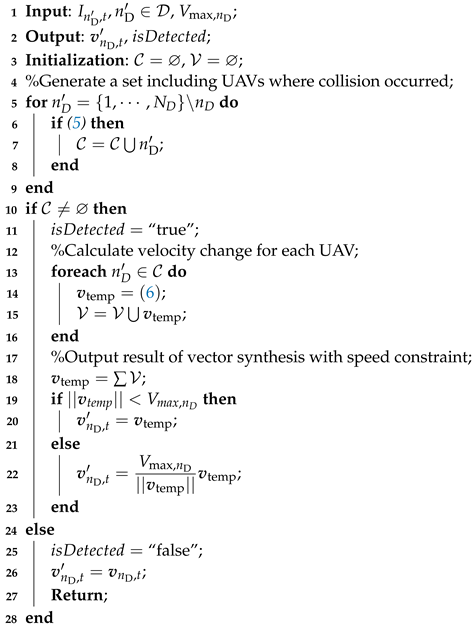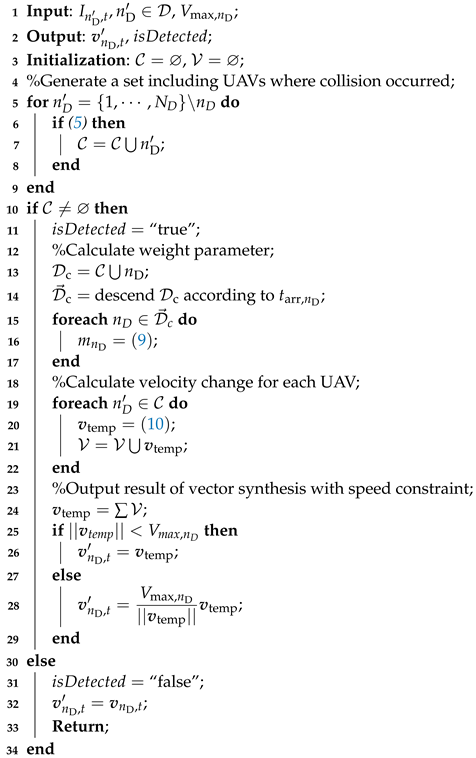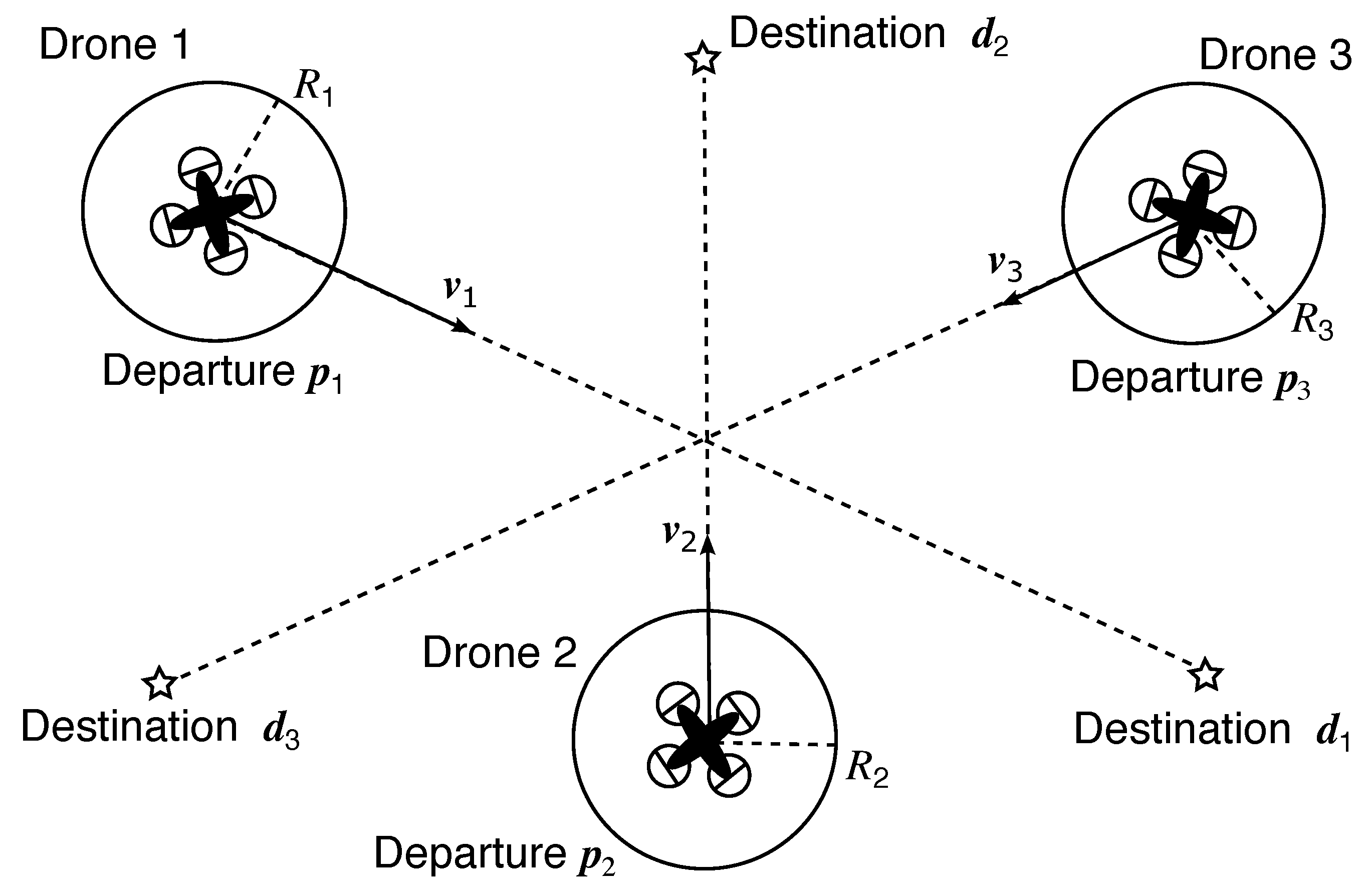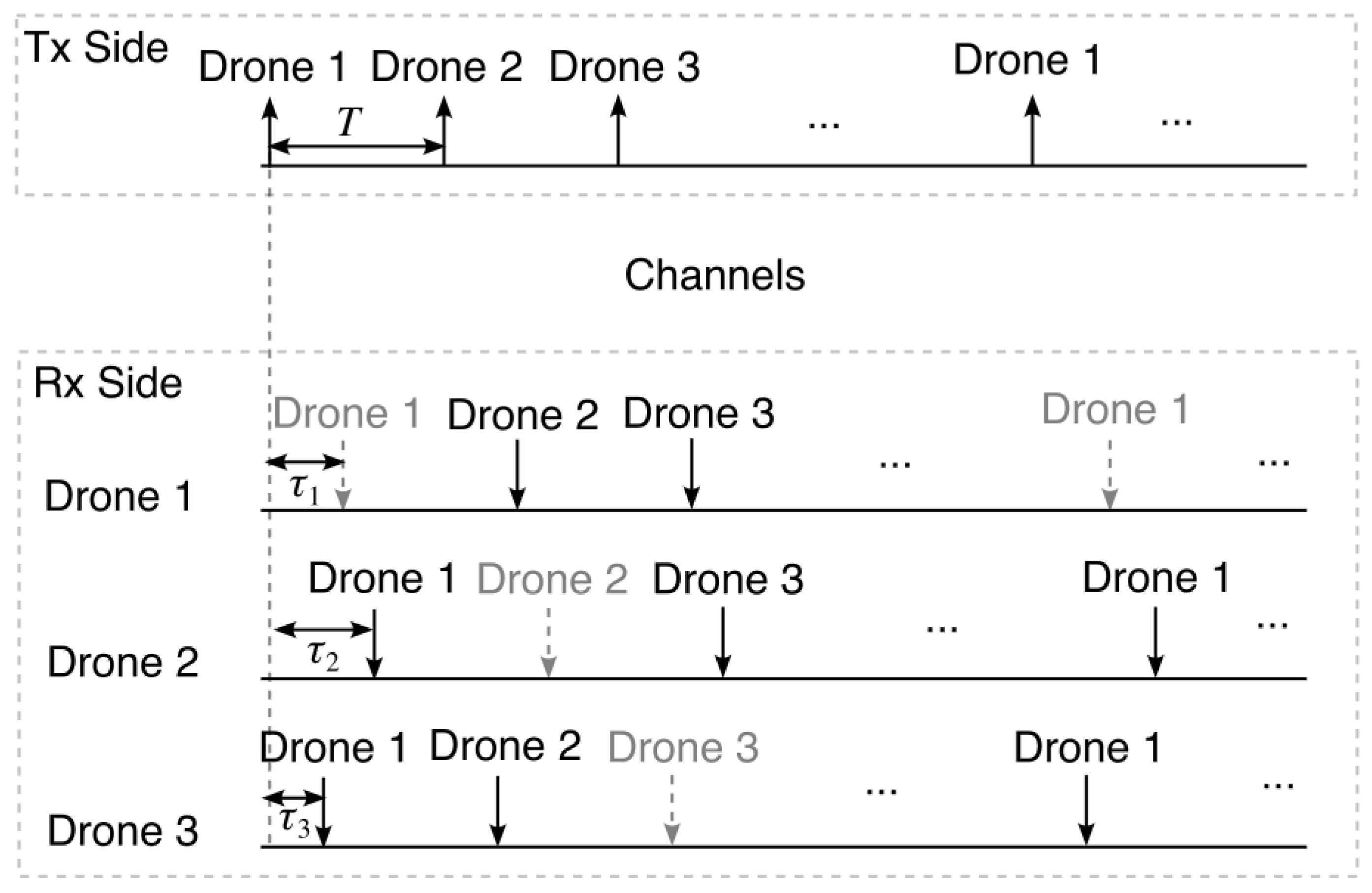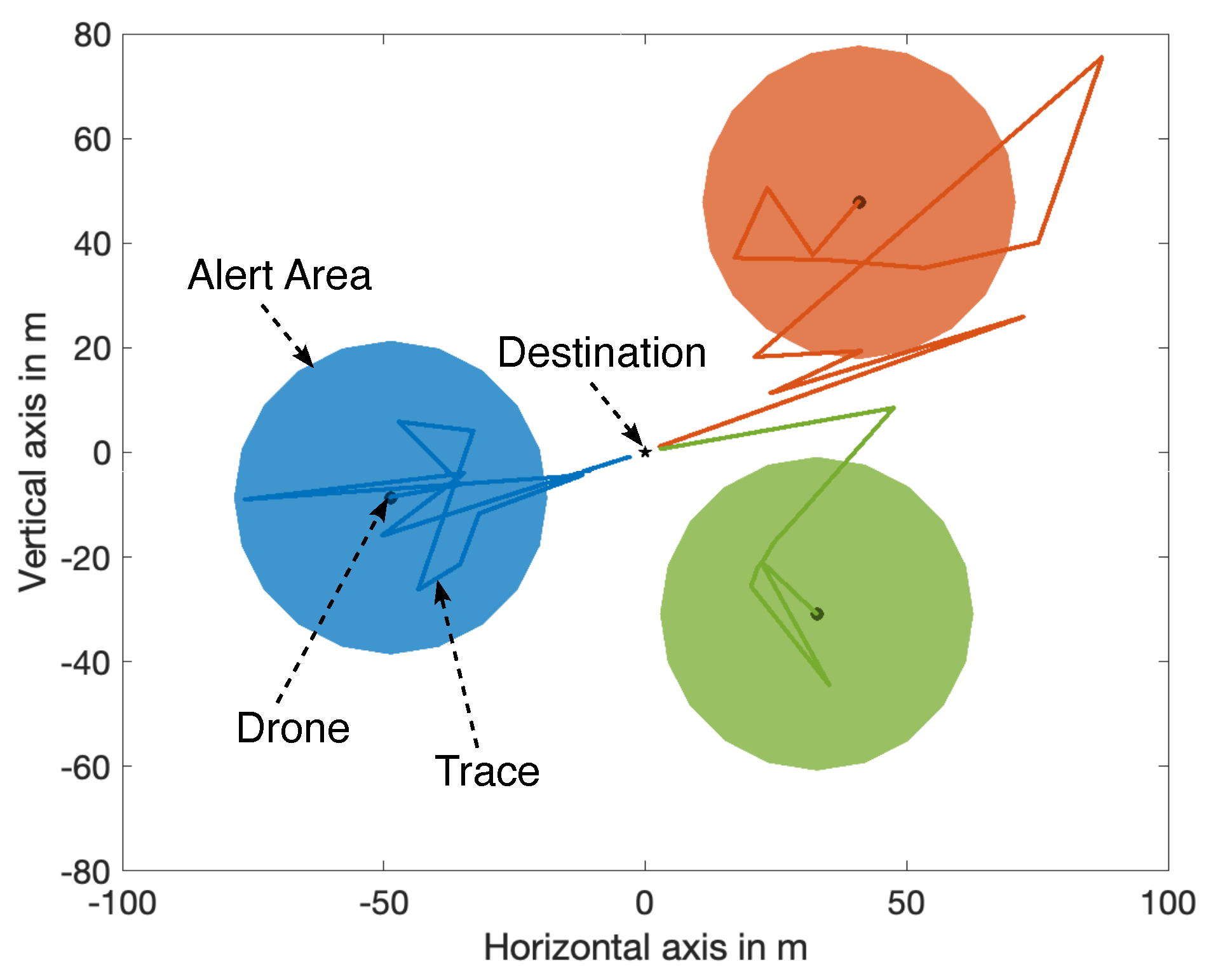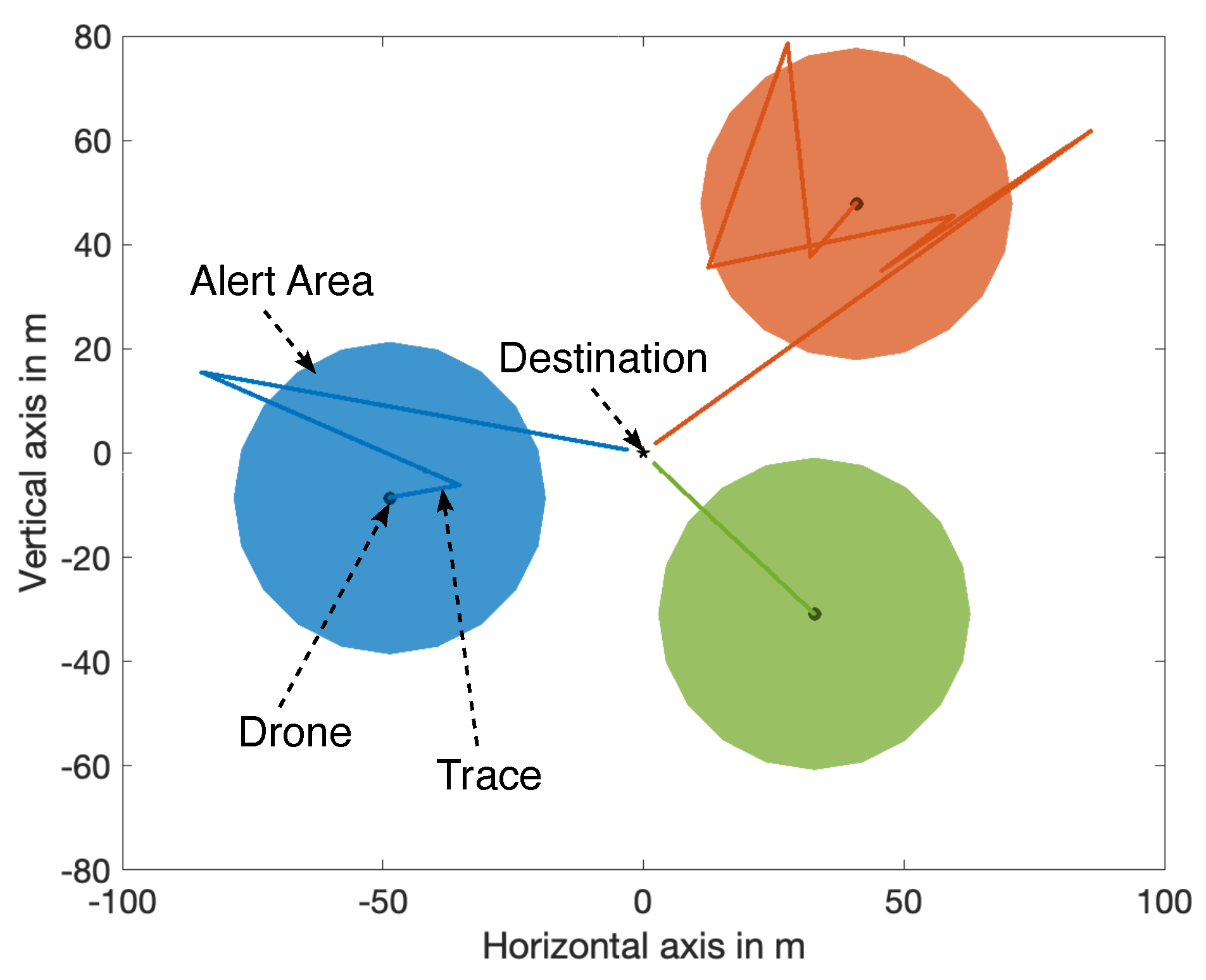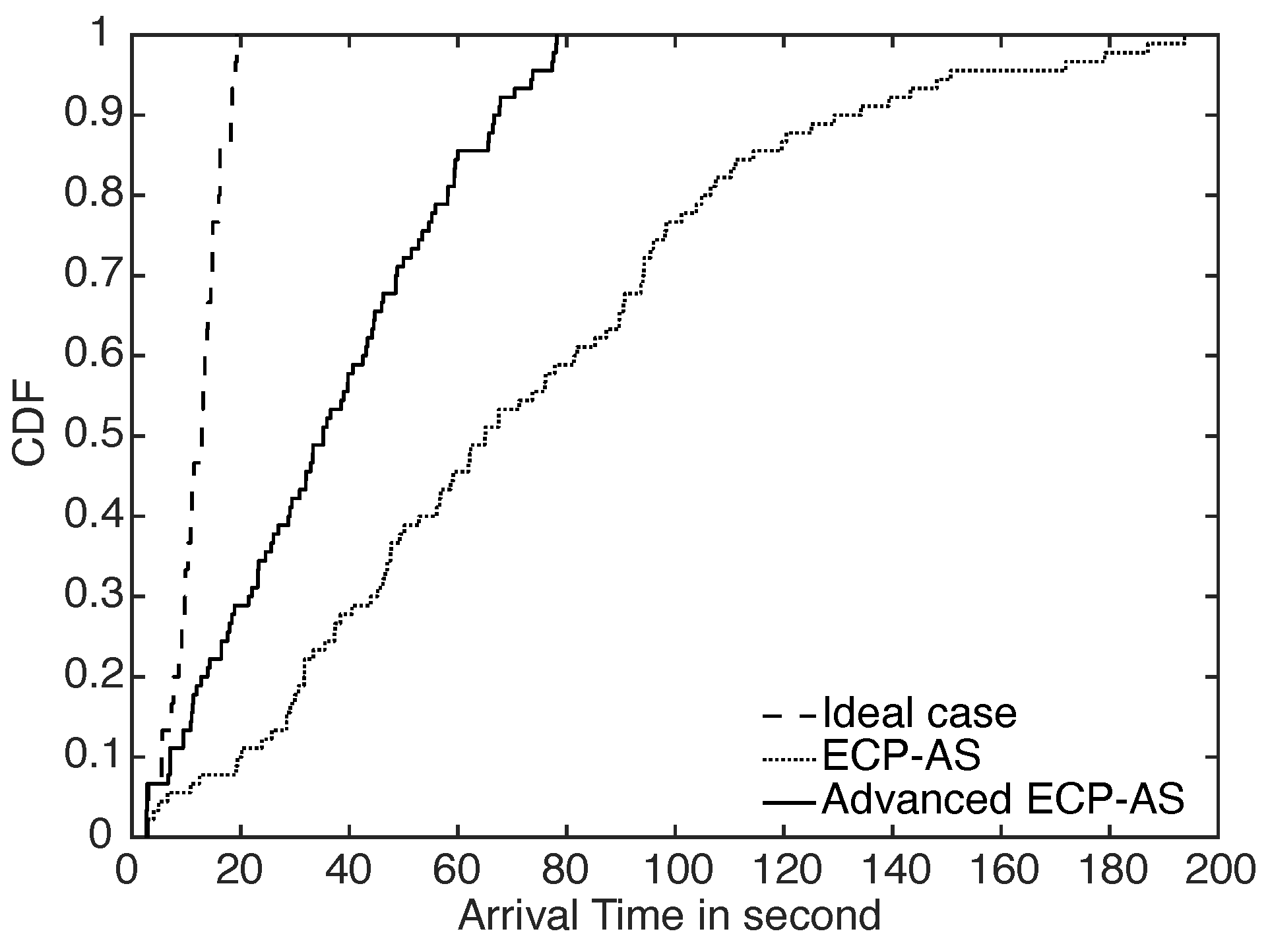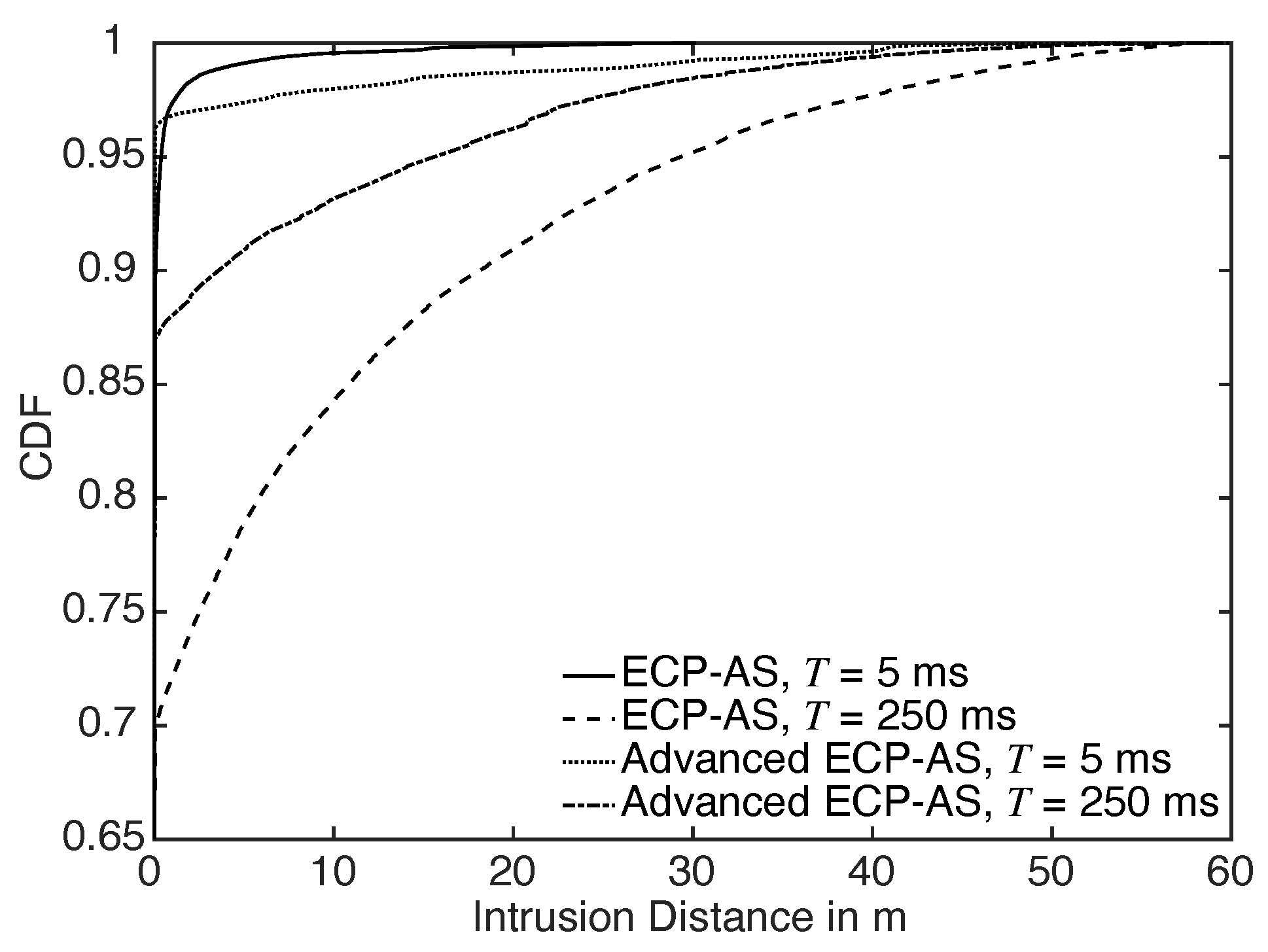1. Introduction
Unmanned aerial vehicles (UAVs), commonly known as drones, have gained widespread popularity in recent years due to their low cost and ability to perform a variety of tasks safely and efficiently. Applications for UAVs include logistics, surveillance, geographical measurement, and more. To enable autonomous UAV flight, a robust network for flight route control is essential, and many research groups around the world are devoted to this topic [
1,
2,
3,
4,
5,
6,
7,
8,
9,
10,
11,
12]. For example, in [
1], a game theory-based method was proposed to address the channel assignment (CA) problem in UAV and device-to-device (D2D)-based networks. Meanwhile, Ref. [
2] applied the non-orthogonal multiple access (NOMA) method to improve the sum rate performance for UAV communications. The probability of using UAVs for D2D communication and D2D communication’s performance were addressed in [
3]. In [
9], a dynamic route control method was proposed for UAV communications, which aimed to improve the throughput and delay performance. In [
10], a trajectory and energy efficiency optimization method was provided for multi-user UAV air-to-ground networks. In [
11], a self-adaptive UAV trajectory method for mobile computing was proposed. In [
12], mobile edge computing was achieved through a UAV communication network. By leveraging UAV communications, researchers are exploring new methods to improve the performance and capabilities of autonomous UAV flight.
Flight route control is a crucial aspect of UAV research as it directly impacts flight safety. Therefore, many researchers have published related results in recent years [
13,
14,
15]. For instance, in [
13], the authors proposed an obstacle detection method to help avoid UAV collision incidents. In [
14,
15], the authors proposed delay prediction and traffic analysis methods for UAVs based on aviation big data. When multiple UAVs are working in a heavy traffic airspace, avoiding collisions becomes an important issue. The adoption of multiple UAVs has become increasingly popular in recent years, with many potential use cases in various industries, such as autonomous logistics, infrastructure inspection, emergency response and surveillance, and data collection for Internet of Things (IoT) applications.
The rapid development of highly mobile UAV groups may cause near-miss collisions between UAVs and aircraft. Without proper collision avoidance methods, there is a significant risk of UAV collision incidents when multiple UAVs are working in the same airspace. To address this issue, researchers have been exploring new collision avoidance methods for multi-UAV applications. These methods are essential for releasing the full potential of UAVs in various industries while maintaining flight safety.
There are two main categories of collision avoidance methods for UAVs: active and negative methods [
16,
17,
18,
19,
20]. Active methods, also known as centralized methods, rely on a centralized control unit to manage flight routes and conditions in real-time, which helps the UAVs under management avoid collisions. However, if unmanaged UAVs appear in the vicinity, active methods are unable to avoid collisions as the centralized control network cannot identify them. Moreover, active methods require a constant cellular network connection, which limits their use in remote areas or during natural disasters.
In contrast, negative methods, also known as distributed methods, equip UAVs with flight control functions, enabling them to perform collision avoidance themselves. Negative methods do not require a centralized infrastructure on the ground, making them suitable for use even outside of cellular service areas. As a result, this study focused on investigating and proposing novel methods for improving the performance of negative-type collision avoidance methods. Negative methods offer several benefits over active methods, including independent operation, flexibility in deployment, and suitability for use in various environments. Improving the performance of negative methods can further enhance the safety and reliability of UAVs in numerous applications.
As mentioned above, the safe operation of multiple UAVs is crucial in various applications, and collision avoidance is a key factor in ensuring flight safety. In this paper, we propose a novel and effective method for performing collision avoidance for multiple UAVs using our designed D2D devices, which allow for UAV location information sharing through D2D communications [
21,
22,
23]. Our method is a distributed-type collision avoidance approach based on the elastic collision principle, which utilizes D2D information sharing to prevent collisions between UAVs. Additionally, we introduce a variable weighting mechanism for each UAV to further improve the efficiency of our proposal. It should be noted that for D2D communications, the issue of security is an essential and emerging topic in recent years. However, many research groups have provided possible solutions, such as [
24].
The rest of this paper is organized as follows. The system model and problem formation are provided in
Section 2. The proposed method is described in
Section 3. Simulations were conducted to verify our proposed method and are presented in
Section 4. Finally, we provide the summary of our work in
Section 5.
2. System Model
In this study, we consider a three-dimensional (3D) flight space in the real atmosphere where
UAVs are randomly deployed. The
UAVs deployed here are assumed to be all multi-rotor UAVs that can change their flying direction with acute angles. For convenience, we define a UAV set as
and write it as
, indexed with
. The 3D coordinates of UAV
in time
t,
, are decided by the uniform distribution on the interval from
to
for the horizontal axis,
to
for the vertical axis, and
to
for the height axis, respectively. UAV
flies to its specified destination
with an initial velocity of
, and the speed
is assumed not to exceed the maximum speed
, which is limited by the physical conditions of the UAV
. In actuality,
refers to the default navigation velocity, and the navigation velocity is invariant in our current system assumption for reducing system complexity. It should be noted that the maximum speed would affect the flying trajectories; we conducted simulations to evaluate its effect in
Section 4.
We imagine a spherical alert area for each UAV and write the radius of the spherical space for UAV
as
where
is defined as a response time in seconds that it takes from receiving the signal to responding to an action. For instance, the parameter
means that it costs 2 s for UAV
to make its speed change after receiving the signal. Each UAV is positioned in the center of its corresponding sphere during the entire flight process. We further configure a weight parameter
and an original arrive time
for UAV
to complete our avoidance method, which is proposed in the next section. An illustration of the considered UAV flight system is shown in
Figure 1.
In the present study, time division duplex (TDD) wireless transmissions are employed for each UAV. On the transmit side, UAVs in
broadcast their information in a sequence based on the TDD principle with period
T. The shared information of UAV
at time
t includes its position
, velocity
, alert radius
, weight
, and original arrive time
and is mathematically expressed as
where
is a weighting parameter that is used in the proposed collision avoidance methods and
is the arrival time with which each UAV directly arrives at its destination based on the navigation velocity. The details about the parameters are described in the following sections.
On the receiver side, in general, the shared information transmitted by any UAV cannot arrive at the same time, and this arrived time is mainly dominated by the distance of the two different UAVs. For simplicity, here we assume a fixed mean delay
for UAV
to model the delay phenomenon of information sharing. An illustration of the TDD-based transmissions for the considered UAV flight systems is shown in
Figure 2.
For the attenuation channels, considering that the UAVs are flying in an open atmospheric space that satisfies the conditions of the Fresnel zone [
25], we introduce a path loss model to simulate signal transmissions among UAVs. Defining
as the distance between UAV
and UAV
at time
t, the received power in dB on UAV
at time
t can be calculated by [
25]
where
is the transmit power of UAV
at time
t in dB.
and
are the antenna gains of UAV
and UAV
, respectively.
is defined as the wavelength at operating frequency for all UAVs [
26]. After the modulated signals pass through the channels and are received by the UAVs, demodulation of the shared information is performed. To better focus on the collision avoidance strategy, in the current study, we assume that the shared information is successfully obtained without any error if the received power
is greater than a received sensitivity
; otherwise, the shared information is discarded. Here, the value of received sensitivity
is decided by the wireless systems that the UAV adopted. Every time a single UAV detects a change in its shared information represented by (
2), the UAV starts to operate the collision avoidance function. In the following section, the proposed collision avoidance methods are introduced in detail.
3. Collision Avoidance Strategy
In this section, we study a collision avoidance strategy for the considered multi-UAV flight systems. To do so, we first provide some explanations about how UAVs arrive at their destinations in our systems and describe some potential security hazards. Thereafter, we propose two collision avoidance methods to solve the problems that we faced.
In common applications, multiple UAVs keep a steady velocity and independently fly alone toward their destinations following the system configurations. Basically, a UAV that is closer to its destination would be the first to complete its flight trip, and other UAVs arrive at their destinations in the order of travel distance if safety issues caused by collisions among UAVs are not considered. Based on this assumption, the original arrive time of UAV
can actually be calculated by
where
is the departure position and
is the initial velocity of UAV
. In fact, however, frequent collisions are hard to ignore because of the increasing UAV density in flight space; therefore, it is unclear whether UAVs can reach their destinations. In the next subsection, we propose a distributed autonomous collision avoidance strategy to ensure that multiple UAVs reach their destinations without collisions.
3.1. Elastic Collision Principle-Aided Avoidance Strategy
The proposed avoidance method for the considered multi-UAV systems was inspired by the phenomenon of elastic collisions between spheres in the real physical world. The basic mechanics of the elastic collision can be described using the conservation of momentum principle. In an elastic collision, the total momentum of the system before the collision is equal to the total momentum of the system after the collision. In fact, elastic collisions play a role in many everyday physical processes. For example, when two objects collide and rebound from each other, this is an example of an elastic collision. In our UAV systems, a UAV with a spherical alert area can also be considered as a sphere object; thus, the collisions among UAVs can be modeled as an elastic collision process.
Benefitting from the embedded wireless communication systems and transport protocol, a UAV can collect and update flight data that are shared from other UAVs, such as position, velocity, and alert radius. Based on this information, the UAV can independently determine if it needs to make an action for avoiding and further calculate a velocity to avoid potential hazards if necessary. In our method, UAV
decides that a collision caused by UAV
occurs if condition
is true, where
and
are from the shared information
that is transmitted by UAV
.
Once the above described collision is determined to occur by UAV
, a velocity should be calculated to avoid potential hazards. According to the elastic collision principle [
27], this velocity
can be obtained by
where
data are also from the shared information
. Note that because the maximum speed of the UAV is limited in practice, the result of (
6) needs to be constrained. Finally, to avoid potential hazards, UAV
changes velocity
to velocity
, where the latter is calculated by
In fact, (
6) is used to calculate velocity
for the case of a collision caused by another UAV. For the case of a collision caused by multiple UAVs, we need to consider each UAV that caused the collision and calculate the corresponding velocity change, then perform a vector synthesis over all of the velocities that we obtained. An elastic collision principle-aided method for calculating the velocity change for a multi-UAV-caused collision is summarized in Algorithm 1.
| Algorithm 1: Elastic collision principle-aided avoidance method. |
![Drones 07 00283 i001 Drones 07 00283 i001]() |
After the calculation of velocity change
, UAV
needs to keep this velocity during time duration
to avoid potential hazards. In the proposed avoidance method, if no other collision occurs during time
, the velocity of UAV
is initialized by
, and UAV
flies to its destination; otherwise, UAV
performs the proposed collision avoidance method and resets time duration
. The whole flight with collision occurrence and avoidance is completed when UAV
arrives at the destination or, in practice, flies a short distance
from its destination. The decision condition of the end of the flight mission for UAV
can be written as
A flowchart of UAV flights using the proposed collision avoidance method is shown in
Figure 3 for a better understanding; note that this flowchart is independently performed by each UAV in the considered multi-UAV systems.
3.2. Advanced Elastic Collision Principle-Aided Avoidance Strategy
Obviously, the scenario of UAV flights without consideration of collisions can ensure an undoubted fairness in which the order that the UAV arrives at its destination is determined by the UAV’s arrival time. The arrival time is an initial parameter and is calculated by the departure position, arrival position, and velocity. This reasonable fairness can be easily guaranteed; however, there are collision hazards during the flight of UAVs because no avoidance strategy is introduced.
On the other hand, by employing our proposed avoidance method in
Section 3.1, it is not difficult to ensure that the UAVs can complete their flight missions without collisions into each other. However, in this method, because the time, place, and object of collision occurrence are dynamically variable, and because one collision occurrence contributes to the production of another collision occurrence, the fairness, i.e., the arrival orders of the UAVs being the same as the original arrive time orders expressed in (
4), cannot be generally ensured. We want to maintain the arrival order, but Algorithm 1 cannot achieve this.
Based on the above description, proposing an avoidance strategy that makes UAVs avoid collisions and arrive in order is necessary. Fortunately, considering the two facts that the mass in a physical elastic collision process also affects the velocity change and that the velocity of an object with a large mass is hardly changed by an object with a smaller mass, we introduce a weight parameter for UAV to control the arrive order of UAV. The core idea of this proposal is that a UAV with a smaller arrive time is assigned a larger weight and can thus hardly have its velocity changed.
Assume that UAV
collided with a UAV collection
; the weight
for
in the present study is set by
where
K is a real number greater than zero and
is the order of UAV
in collection
. The numbers in collection
are the numbers in
arranged in descending order according to the arrive time
and shared by
. We thereafter calculate the changed velocity
when a collision occurs between UAV
and UAV
by
Finally, in the same way as the proposed method in
Section 3.1, we modify the velocity
by the maximum speed constraint expressed in (
7). The advanced elastic collision principle-aided method for calculating the velocity change for a multi-UAV-caused collision is summarized in Algorithm 2. Similar to
Section 3.1, the flowchart of UAV flights based on this method can be also found in
Figure 3 for details.
| Algorithm 2: Advance elastic collision principle-aided avoidance method. |
![Drones 07 00283 i002 Drones 07 00283 i002]() |
It is worth noting that both methods proposed in this section used a maximum speed-limited elastic collision principle to calculate the velocity change when a collision occurred among UAVs. Obviously, if the maximum speed of each UAV is not limited, the elastic collision principle can work smoothly and theoretically ensures that UAVs are separated from each other after a collision. In reality, however, UAVs may not separate from each other as quickly as we thought because a speed constraint has been introduced. Simply speaking, the velocity calculated by (
6) or (
10) is necessary for avoiding a collision but is limited by (
7). In the next section, we provide more evaluations on this speed constraint and summarize the key findings.
4. Computer Simulation
To verify the performance of the proposed collision avoidance methods, in this section, we conducted computer simulations using Matlab simulator and analyzed the simulation results. Here, we considered a special simulation scenario where all UAVs are flying towards the same destination at the center location, which is the worst case with the largest possibility of collision; we wanted to use this toughest case to validate the effectiveness of the proposed method. After each UAV arrives at its destination, it stops flying and lands on the ground. The two collision avoidance methods under evaluation are (a) the method using collision avoidance Algorithm 1 and (b) the method using collision avoidance Algorithm 2. The simulation parameters are listed in
Table 1. It should be noted that in
Table 1, the height axis range is set to be 0 to maximize the probability of collision for better evaluating our proposals. In the following paragraph, for the sake of simplicity, we denote method (a) as “ECP-AS” (elastic collision principle-aided avoidance strategy), and method (b) as “Advanced ECP-AS”, respectively. In
Figure 4 and
Figure 5, we simulate and show the flight traces of a multi-UAV system for method (a) using ECP-AS and method (b) using advanced ECP-AS as examples, setting
for a better understanding.
Considering that Algorithm 2 is designed to maintain the characteristics of Algorithm 1 while also ensuring that the UAVs can arrive at their destination in their original order as much as possible, in
Figure 6, we first show the cumulative distribution function (CDF) of the UAV arrival time for the above two methods, i.e., while using ECP-AS and advanced ECP-AS, using simulations with
for three trials. Here, the arrival time means the elapsed time that each UAV flies from its starting position to the destination position. Aside from using the ECP-AS and advanced ECP-AS methods, the results of the case where all UAVs independently fly to the destination were also calculated and are shown in
Figure 6, and it is marked as the “ideal case”. Based on the distribution shown in
Figure 6, we found that, as we had anticipated, all UAVs using advanced ECP-AS reached their destinations in less time compared with ECP-AS. However, when compared with the ideal case, the UAVs spent more time. The main reason for this is that we introduced a weighting parameter
in Algorithm 2 to ensure that the UAV that should arrive at its destination first during each conflict does not change its flight direction. Instead, advanced ECP-AS introduces more time due to conflicts compared with the ideal case. Consequently, each UAV using advanced ECP-AS spends more time than the ideal case, but less time than those using ECP-AS.
Thereafter, we evaluated the avoidance effect caused by the proposed ECP-AS and advanced ECP-AS systems. To accomplish this, we need to define a parameter
, which is named the intrusion distance of UAV
to UAV
at time
t, and we calculate this distance using
From (
11), we can easily understand that the intrusion distance
ranges from 0 to
, and UAV
and UAV
collide when
for arbitrary time
t; meanwhile, we can assume that risk of collision between two UAVs decreases with the decrease in
.
In the considered multi-UAV flight systems, there are two potential parameters that may affect the above intrusion distance: one is period
T for the TDD transmissions, and the other one is the mentioned maximum speed constraint
. The period
T affects the frequency of information sharing, and a larger period
T leads to a larger intrusion distance and a subsequently greater risk of collision between two UAVs because of serious delays occurring in information sharing processes. The introduced maximum speed constraint
breaks the completeness of the elastic collision principle and leads to an increase in the collision probability because two UAVs cannot separate in time after a collision has occurred. For simplicity, we define a parameter
to represent the ratio of the allowed maximum speed to the speed of the initial velocity of UAV
, which is expressed as
In the following paragraph, we provide more evaluations to verify our explanation.
Figure 7 shows the CDF of the intrusion distance for
and
with a relatively loose maximum speed constraint of
. Here,
means that the TDD transmission occurs four times every second, and
is the smallest realizable value for
T considering the computational cost and complexity. From this figure, it can be seen that all intrusion distances in the overall observation time are less than the theoretical maximum
using both avoidance methods, which implies that the UAVs can reach their destinations safely without colliding with each other. Moreover, a higher frequency (i.e., smaller
T) of information sharing can easily lead to smaller intrusion distance and better performance in the collision avoidance process, regardless of which avoidance method was adopted. The result confirmed our previous assumption about period
T affecting the delay of information sharing. In addition, the curves also indicate that the advanced ECP-AS provides a better “0” intrusion distance (i.e.,
) than the ECP-AS method, while this advantage decreases as
T decreases.
To verify the effect caused by the maximum speed constraint, in
Figure 8, we show the CDF of intrusion distance for
and
for all
with a better period condition of
. Similar to the effect caused by the period
T, this figure indicates that all intrusion distances in the overall observation time are less than the theoretical maximum
using both avoidance methods, which further confirms that the UAVs completed their flight trips under the safest condition. Furthermore, a looser maximum speed constraint (i.e., larger
) can also easily lead to a smaller intrusion distance and better performance in the collision avoidance process for both proposed avoidance strategies. The results support our opinion that the maximum speed constraint broke the completeness of the elastic collision principle used in the proposed avoidance strategies. In addition, the curves also indicate that the advanced ECP-AS method provides a better “0” intrusion distance than the ECP-AS method.
